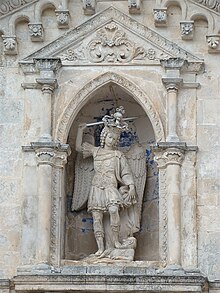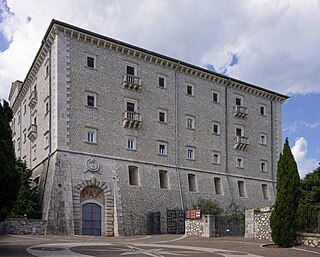
Monte Cassino is a rocky hill about 130 kilometres (80 mi) southeast of Rome, in the Latin Valley, Italy, 2 kilometres west of Cassino and at an elevation of 520 m (1,710 ft). Site of the Roman town of Casinum, it is widely known for its abbey, the first house of the Benedictine Order, having been established by Benedict of Nursia himself around 529. It was for the community of Monte Cassino that the Rule of Saint Benedict was composed.

Germanus of Auxerre was a western Roman clergyman who was bishop of Autissiodorum in Late Antique Gaul. He abandoned a career as a high-ranking government official to devote his formidable energy towards the promotion of the church and the protection of his "flock" in dangerous times, personally confronting, for instance, the barbarian king "Goar". In Britain he is best remembered for his journey to combat Pelagianism in or around 429 AD, and the records of this visit provide valuable information on the state of post-Roman British society. He also played an important part in the establishment and promotion of the Cult of Saint Alban. The saint was said to have revealed the story of his martyrdom to Germanus in a dream or holy vision, and Germanus ordered this to be written down for public display. Germanus is venerated as a saint in both the Roman Catholic and Orthodox churches, which commemorate him on 31 July.

Michael, also called Saint Michael the Archangel, Archangel Michael and Saint Michael the Taxiarch is an archangel in Judaism, Christianity, Islam, and the Baha'i faith. The earliest surviving mentions of his name are in third- and second-century-BC Jewish works, often but not always apocalyptic, where he is the chief of the angels and archangels, and he is the guardian prince of Israel and is responsible for the care of Israel. Christianity adopted nearly all the Jewish traditions concerning him, and he is mentioned explicitly in Revelation 12:7–12, where he does battle with Satan, and in the Epistle of Jude, where the author denounces heretics by contrasting them with Michael.

The Sanctuary of Saint Michael the Archangel is a Roman Catholic shrine on Mount Gargano, Italy, part of the commune of Monte Sant'Angelo, in the province of Foggia, northern Apulia. It has the dignity of a minor basilica.

Januarius, also known as Januarius I of Benevento, was Bishop of Benevento and is a martyr and saint of the Catholic Church and the Eastern Orthodox Church. While no contemporary sources on his life are preserved, later sources and legends claim that he died during the Great Persecution, which ended with Diocletian's retirement in 305.

May 7 - Eastern Orthodox Church calendar - May 9

The military saints, warrior saints and soldier saints are patron saints, martyrs and other saints associated with the military. They were originally composed of the early Christians who were soldiers in the Roman army during the persecution of Christians, especially the Diocletianic Persecution of AD 303–313.

Monte Sant'Angelo is a town and comune of Apulia, southern Italy, in the province of Foggia, on the southern slopes of Monte Gargano. It is one of I Borghi più belli d'Italia.

The Blickling homilies are a collection of anonymous homilies from Anglo-Saxon England. They are written in Old English, and were written down at some point before the end of the tenth century, making them one of the oldest collections of sermons to survive from medieval England, the other main witness being the Vercelli Book. Their name derives from Blickling Hall in Norfolk, which once housed them; the manuscript is now at Princeton, Scheide Library, MS 71.
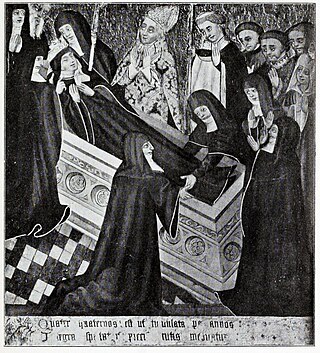
Seaxburh, also Saint Sexburga of Ely, was a Queen as well as an abbess, and is a saint of the Christian Church. She was married to King Eorcenberht of Kent.

San Marco in Lamis is a town and comune in the province of Foggia in the Apulia region of southeast Italy. It is located in the Gargano massif area within the Parco Nazionale del Gargano and it belongs to the Comunità Montana del Gargano. Part of the Via Sacra Langobardorum runs through the town's territory. As such, the town is home to the Santuario di Santa Maria di Stignano and the Convento di San Matteo apostolo. The Santuario di Santa Maria di Stignano is linked to the Castelpagano Castle, whose ruins dominate a slope in the territory of Apricena.
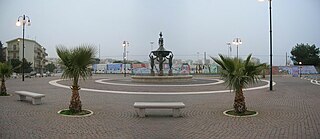
Siponto was an ancient port town and bishopric of Magna Graecia in Apulia, southern Italy. The town was abandoned after earthquakes in the 13th century; today the area is administered as a frazione of the comune of Manfredonia, in the province of Foggia. Siponto is located around 3 km south of Manfredonia.
Goscelin of Saint-Bertin was a Benedictine hagiographical writer. He was a Fleming or Brabantian by birth and became a monk of St Bertin's at Saint-Omer before travelling to England to take up a position in the household of Herman, Bishop of Ramsbury in Wiltshire (1058–78). During his time in England, he stayed at many monasteries and wherever he went collected materials for his numerous hagiographies of English saints.

The Liber Eliensis is a 12th-century English chronicle and history, written in Latin. Composed in three books, it was written at Ely Abbey on the island of Ely in the fenlands of eastern Cambridgeshire. Ely Abbey became the cathedral of a newly formed bishopric in 1109. Traditionally the author of the anonymous work has been given as Richard or Thomas, two monks at Ely, one of whom, Richard, has been identified with an official of the monastery, but some historians hold that neither Richard nor Thomas was the author.

Saint Michael the Archangel is referenced in the Old Testament and has been part of Christian teachings since the earliest times. In Catholic writings and traditions he acts as the defender of the Church and chief opponent of Satan, and assists people at the hour of death.
Bartholomew of Trent was a Dominican hagiographer and papal diplomat. His Epilogum in gesta sanctorum, which set a new style in hagiography designed for practical use by preachers, specifically to inspire a lay audience with marvels and moral admonitions, was one of two main sources for Jacobus de Voragine's compendium, Golden Legend.
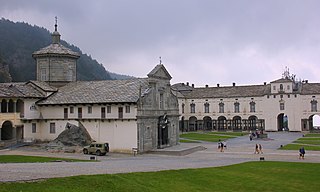
The Sanctuary of Oropa is a group of Roman Catholic buildings and structures in Oropa, frazione of the municipality of Biella, Italy. It is located at a height of 1,159 metres in a small valley of the Alpi Biellesi.
Hagrold, also known as Hagroldus, Harold, and Harald, was a powerful tenth-century Viking chieftain who ruled Bayeux. He was apparently a pagan from Scandinavia, and seems to have seized power in Normandy at about the time of the death of William, Count of Rouen. His career can be interpreted in the context of aiding the Normans against the intrusion of Frankish authority, or conversely in the context of taking advantage of the Normans.

Giorgio Otranto was an Italian historian, specialized in the history of early Christianity.
Rerum italicarum scriptores ab anno æræ christianæ quingentesimo ad millesimumquingentesimum is a collection of texts which are sources for Italian history from the 6th to the 15th century, compiled in the 18th century by Ludovico Antonio Muratori.
